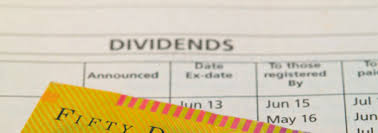This report is not a personal recommendation and does not take into account your personal circumstances or appetite for risk.
Dividends: your share of profits; reward for taking the risk of investing. But not all payments are equal. While traditional shareholders must wait for the payment date others can be paid up to 50 days earlier. How?
 CFDs are a cash-settled derivative, based on the underlying share price. You can trade any rise (or fall) in the underlying share price, but need only put down a 20% deposit. This magnifies any gains, but also magnifies any losses. CFDs are still eligible for dividends and best of all – no stamp duty, although there are financing costs.
CFDs are a cash-settled derivative, based on the underlying share price. You can trade any rise (or fall) in the underlying share price, but need only put down a 20% deposit. This magnifies any gains, but also magnifies any losses. CFDs are still eligible for dividends and best of all – no stamp duty, although there are financing costs.
What’s the attraction? Being able to capitalise on any share price recovery during the dividend payment timeline.
To prevent any buying of shares just before a dividend is paid, aiming for a risk-free trade, the dividend process starts 10-50 days earlier: the ex-dividend date (Thursdays). From this day, you can no longer buy the shares with the right to receive the upcoming dividend.
On the ex-dividend date (Thurs) the price will adjust down, to reflect the planned cash outflow from the company. The eventual dividend payment compensates you for the aforementioned adjustment. But CFD positions are made good immediately.
This can allow you to benefit from the general belief that share prices have potential (no guarantee) to recover the adjustment over time. How so? Firstly, hunters spying a bargain on the chart, hoping the gap will get filled. Secondly, because shareholders tend to reinvest dividends in the same shares, to benefit from compound investing.
 Who’s paying dividends early to CFD holders next week? Taylor Wimpey will pay a whopping 6.4% special dividend, a whole 27 days early. J Sainsbury pays 4%, also 27 days early. B&Q owner Kingfisher offering 3.5% 28 days in advance while Vodafone will pay 2.8% a whole 42 days sooner. Average: 31 days early.
Who’s paying dividends early to CFD holders next week? Taylor Wimpey will pay a whopping 6.4% special dividend, a whole 27 days early. J Sainsbury pays 4%, also 27 days early. B&Q owner Kingfisher offering 3.5% 28 days in advance while Vodafone will pay 2.8% a whole 42 days sooner. Average: 31 days early.
What’s the trade? Trade 1: Open a position (needs just a 20% deposit) before Wednesday’s close. Receive the full dividend Thursday morning, offset by a corresponding share price drop. The hope is that the share price recovers this drop in full (maybe more, maybe less) over the following weeks. If the position gets back to break-even, the dividend is all profit.
Trade 2: Do all the above, but if the share price falls less than the value of the dividend on Thursday (the share price may even go up if there is good news about the company) then you can immediately close the trade in a profit with the dividend payment being bigger than the loss on the shares.
Trade 3: Wait for the shares to go ex-dividend, and the share price to fall, then buy the shares in the hope of recovery.
In recent weeks:Whitbread has more than recovered yesterday’s 67p (1.5%) payment thanks to some good news. Marks & Spencer has recovered half of yesterday’s 3% payment. Bunzl has recovered the full 35p (1.65%) it paid on Thurs 23rd. GlaxoSmithKline has recovered 11p of the 19p (1.2%) it paid on 16 May and Inchcape has recovered by 20p, having paid out 17p (3%) on the 16th May. Not bad going.
 Accendo Markets offers its clients the very latest information about dividends; who, when, how much, what yield, how many days earlier. We also monitor how shares fare in terms of recovery following their latest payment.
Accendo Markets offers its clients the very latest information about dividends; who, when, how much, what yield, how many days earlier. We also monitor how shares fare in terms of recovery following their latest payment.
To take advantage of Taylor Wimpey, Kingfisher, Sainsbury or Vodafone dividends next week open an account.
To make sure you always know who is paying dividends next, get access to our award-winning research.
And on that note, enjoy the Champions League Final.
Mike van Dulken, Head of Research, 31 May 2019
This research is produced by Accendo Markets Limited. Research produced and disseminated by Accendo Markets is classified as non-independent research, and is therefore a marketing communication. This investment research has not been prepared in accordance with legal requirements designed to promote its independence and it is not subject to the prohibition on dealing ahead of the dissemination of investment research. This research does not constitute a personal recommendation or offer to enter into a transaction or an investment, and is produced and distributed for information purposes only.
Accendo Markets considers opinions and information contained within the research to be valid when published, and gives no warranty as to the investments referred to in this material. The income from the investments referred to may go down as well as up, and investors may realise losses on investments. The past performance of a particular investment is not necessarily a guide to its future performance.
Prepared by Michael van Dulken, Head of ResearchComments are closed.